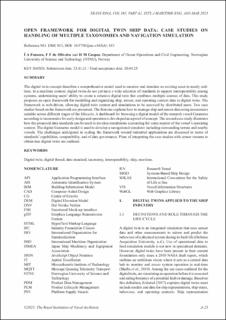OPEN FRAMEWORK FOR DIGITAL TWIN SHIP DATA: CASE STUDIES ON HANDLING OF MULTIPLE TAXONOMIES AND NAVIGATION SIMULATION
Peer reviewed, Journal article
Published version

Åpne
Permanent lenke
https://hdl.handle.net/11250/3120531Utgivelsesdato
2023Metadata
Vis full innførselSamlinger
Originalversjon
International Journal of Maritime Engineering. 2023, 165 (1), A23-A42. 10.5750/ijme.v165iA1.813Sammendrag
The digital twin concept describes a comprehensive model used to monitor and simulate an existing asset in nearly real-time. In a maritime context, digital twins do not yet have a wide selection of standards to support interoperability among systems, undermining users’ ability to create a cohesive digital twin that combines multiple sources of data. This study proposes an open framework for modelling and organizing ship, sensor, and operating context data in digital twins. The framework is web-driven, allowing digital twin content and simulations to be accessed by distributed users. Two case studies based on the framework are presented. The first one explains how to manage ship and sensor data using taxonomies suitable across different stages of the lifecycle. A dashboard for browsing a digital model of the research vessel Gunnerus according to taxonomies for early design and operation is developed as a proof of concept. The second case study illustrates how the proposed data standards can be used to develop simulations accounting for some aspects of the vessel’s operating context. The digital Gunnerus model is used to develop a navigational simulator including surrounding terrain and nearby vessels. The challenges anticipated in scaling the framework toward industrial applications are discussed in terms of standards’ capabilities, compatibility, and of data governance. Plans of integrating the case studies with sensor streams to obtain true digital twins are outlined.